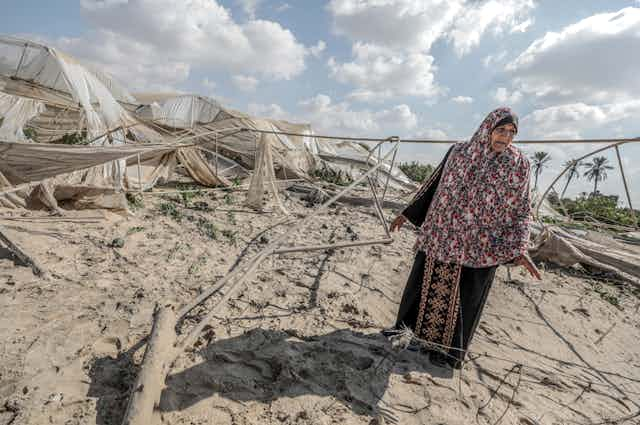“Control oil, and you control nations; control food and you control people.” This aphorism, often attributed to Henry Kissinger, recently came to mind when I saw first hand how both strategies have been effectively deployed in Israel’s occupation and blockade of Gaza.
As a researcher of conflict-affected food and farming systems I was in the encircled territory, some 50km by 10km and home to 2.2 million Palestinians, to explore how it could recover its food sovereignty. I was particularly struck by the enduring food traditions associated with its rich trading history, and how local varieties, inextricably linked to life in Gaza, are under threat.
As the most recent Israeli war on Gaza in August fades from view, it’s worth looking at how recent history has shaped the territorial food system and stretched it to breaking point.
Farming Gaza’s sandy coastal soils requires skills honed over generations. Local varieties of olive, date palm, citrus and grape have been uniquely adapted over millennia to cope with its saline conditions. The heavier clay-based soils to the eastern border of what is now the Gaza Strip hold enough moisture and fertility to support rain-fed agriculture.
Today, farming in Gaza takes place primarily in and around urban areas, caught between the annexation of its border farms and urban expansion. A quarter of the population, mostly women, derive their livelihoods from small-scale family farming as both paid and unpaid labour. Nonetheless, and somewhat remarkably, Gaza has proved that it can be self-sufficient in fruits and vegetables. In theory that’s enough to feed its population and bring in export revenue.

However, repeated airstrikes under 55 years of occupation, and a 15-year blockade have dramatically shaped Gaza’s production and consumption patterns. Despite being self-sufficient in some crops, pressures on grazing and arable land result in woefully low cereal production and available animal protein.
This dietary shortfall is picked up by the UN, with food baskets supplied to the 68% of the population that is food insecure, and by imports from Israel. The occupied Palestinian territory constitutes Israel’s third largest export market (after the US and China).
Degraded soil and imported seeds
In an attempt to compete with highly-subsidised food imports, many farmers have become dependent on imported synthetic fertilisers and pesticides. These effectively increase the cost of local production and undermine soil biology and its ability to retain moisture and fertility. Nitrate leaching has become a major source of groundwater pollution.

Increased dependence on hybrid seeds displaces highly adapted and nutrient-rich open-pollinated baladi (local) seeds that can be saved and sown again each year. These are at the heart of Gaza’s food culture, and the diversity they represent is essential for climate change adaptation.
Water, energy and wasted
As Gaza’s population has grown, its coastal aquifer, which once provided the territory’s fresh water, has been over-exploitated and contaminated by sea water. It is now considered unfit for human consumption or irrigation.
Israel’s systematic targeting of Gaza’s energy, sewage and water infrastructure, which is integral to any food system, and its refusal to allow access to equipment for repair or replacement, has accelerated what the UN describes as Gaza’s de-development.
Airstrikes on Gaza’s only power plant and largest sewage treatment plant in 2008 resulted in the release of 100,000 cubic metres of sewage into neighbouring homes and farmland. In 2018, Israeli destruction of sanitation infrastructure resulted in further environmental breakdown, leaving raw solid and liquid wastes being discharged into the Mediterranean, threatening the fish stocks that Gazan fishers and consumers depend upon.
Internationally funded sewage treatment plants may, for now, have reduced sewage flows. But there remains the persistent threat of limited capacity, faltering energy supplies and future attacks.
Shrinking territory
Israel “disengaged” from Gaza in 2005, purportedly to “return” land previously under Israeli settlements and militarised zones. Yet occupation was effectively increased in the form of “access restricted areas”.

Over a third of Gaza’s farmland is in these no-go zones along the northern and eastern borders that once formed the territory’s fruit and bread baskets. The exact range of the zone is undeclared but is understood to vary between 300 and 1,000 metres.
Those who stray too close to these areas risk being shot and their equipment confiscated or destroyed. Along the 60km land border, Israel deploys border posts, some “manned” by remote-controlled machine guns, ground sensors, and drones. Similarly, access to Mediterranean waters is restricted to between six and 15 nautical miles from the coast, depriving Gaza’s artisanal fishers of full access to the most productive fishing grounds.
Already in 2022, there have been 644 incidents of shooting to prevent access to land or sea.
Destruction of farmland
Despite the now-normalised blockade and regular airstrikes, land invasions still pose the most significant threat. Between 2000 and 2008 it is estimated that 112,000 olive trees were uprooted during Israeli “incursions”.
After Operation Cast Lead (2008-9), the UN documented destruction of soils, vegetable crops, orchards, livestock, wells, hatcheries, beehives, greenhouses, irrigation networks, barns and stables. Replacement or young fruit trees are ill-adapted to saline conditions, and so cannot survive.
After Operation Protective Edge (2014) the UN was denied access, but reported that the destruction of critical infrastructure had become “a recurring reality”.


Biannual herbicide spraying by Israel, allegedly for security purposes, damages hundreds of acres of crops. And regular incursions with bulldozers destroy many more acres of farmland.
Compensation for the destruction of farmland and infrastructure by the Israeli state is supposed to be met by the UN through contributions from member states. To date, no compensation has been made to Palestinian farmers.
Ultimately the international community, in supporting food “security” while quietly covering the costs of damage, remains complicit in its silence. Israel’s violence against Palestinian food and farming systems renders dignified healthy food impossible. Gaza, before much longer, may indeed become uninhabitable.

